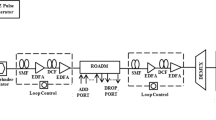Abstract
Conventional optical wavelength division multiplexing (WDM) networks calls for optoelectronic conversion for each wavelength in every node plus a large management effort for proper packet routing. All-optical networks are still unavailable. Here, a new architecture is described where the optical transport is done without conversions (except at extreme nodes), and with minimal routing management effort. The present basic mechanism is, firstly, to gather (at any source node) the packets demanding for a certain destination node K. Secondly, all these packets are modulated onto wavelength λK. Next, the wavelength is routed towards node K by passive directional devices. As other source nodes reuse wavelength λK, an anti-collision mechanism is presented. This mechanism uses very economic and widely available components. The present arrangement seems to be pre-wired, conveying packets from source to destination nodes almost automatically. The present arrangement is simpler and far more economical than (G)MPL(λ)S arrangements, for instance. Additionally, the present system does not demand for expensive wavelength conversions or central protocols. The disadvantage over (G)MPL(λ)S is that the present arrangement limits its maximum number of operational nodes to the number of wavelenghts WDM is able to support.
Similar content being viewed by others
References
B. Mukherjee, Optical Communications Networks, (McGraw–Hill, New York, 1997).
accesFIBER network management system, (Agilent Technologies 2001); Overview brochure, accessed (Oct. 1, 2001) at: 〈 http:/ /www.agilent.com/cm/rdmfg/accessfiber/ 〉
R. Lingampalli, L. Ceupens, Switching to photonics in the metro, Lightwave, (June 2001), pp. 72–80.
A. Podcameni, M. Mosso, Smart wavelength routing assignment in transoceanic optical wdm rings with latency management by using super–packets, in: Proceedings of the Annual Multiplexed Telephony Conference, AMTC 2000, San Diego, CA, vol. 2, (July 2000), pp. 179–190.
D. G. West, Introduction to Graph Theory 2nd ed. (Prentice–Hall, Upper Saddle River, NJ., 2000).
A. Podcameni, J. Lopes, Using a simple algorithm and platform in optical DWDM networks for reaching a satisfactory wavelength–routing assignment, Microwave and Optical Technology Letters, vol. 28, (March 20, 2001), pp. 406–410.
R. Doverspike, J. Yates, Challenges for MPLS in optical network restoration, IEEE Communication Magazine, vol. 39,no. 2, (Feb. 2001), pp. 89–96.
Author information
Authors and Affiliations
Rights and permissions
About this article
Cite this article
Podcameni, A., Mosso, M.M. & da Silva, E.S. WDM Intelligent Transport Network for All-Optical Routing. Photonic Network Communications 4, 205–210 (2002). https://doi.org/10.1023/A:1015347530228
Issue Date:
DOI: https://doi.org/10.1023/A:1015347530228




